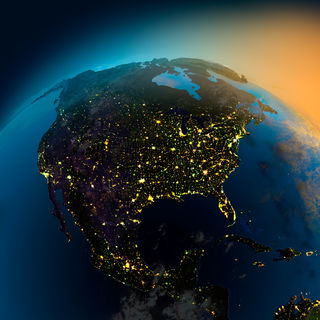Health
Too Much Artificial Light Exposure Can Make You Sick
Maintaining natural 24-hour circadian rhythms is essential for your well-being.
Posted July 14, 2016

Health experts are increasingly aware that limiting your exposure to artificial light—while making sure to get some exposure to natural light—within a given 24-hour cycle is key to staying healthy. New research shows that the last century of artificial light pollution is an environmental hazard that is causing our circadian rhythms—which have evolved since the beginning of time—to go haywire.
It's no wonder our chronobiological clocks are discombobulated. After relying on the sun, moon, and stars to guide our waking and sleeping hours for millennia, it's been less than 100 years since humans en masse have been exposed to artificial lighting—which has become omnipresent in the early 21st century.
From a historical perspective, it's hard to imagine that Thomas Edison didn't even invent the lightbulb until 1878. At the time, he declared, "We will make electricity so cheap that only the rich will burn candles." In 1882, Edison opened his Pearl Street Power Station which provided electricity to a handful of customers in lower Manhattan for the first time in history. Electricity and artificial lighting didn't became widely available in the United States until the 1930s.
The rising and setting of the sun influences every cell in our bodies and is literally hardwired into your neurobiology. Almost every organism on earth—from single-cell algae to humans—has an internal circadian clock that corresponds closely with the seasonal 24-hour cycles of darkness and light.
Human sleep patterns are largely governed by our internal circadian clock. In humans and animals, circadian patterns follow a 24-hour cycle which is directed by the circadian control center of the brain, called the suprachiasmatic nucleus (SCN), located in the hypothalamus.
In 2013, researchers at MIT reported that when circadian rhythm are thrown off, health problems including obesity and metabolic disorders such as diabetes can arise. People who work night shifts have an increased susceptibility to obesity and diabetes. The researchers at MIT also discovered a link between a disruption in circadian cycles and aging. In a statement,Leonard Guarente senior author of the paper said,
"Just about everything that takes place physiologically is really staged along the circadian cycle. What's now emerging is the idea that maintaining the circadian cycle is quite important in health maintenance, and if it gets broken, there's a penalty to be paid in health and perhaps in aging."
Today, a new animal study from the Netherlands reports that constant exposure to light triggered pro-inflammatory activation of the immune system, muscle loss, and early signs of osteoporosis.
The July 2016 study, "Environmental 24-Hour Cycles Are Essential for Health," was published in the journal Current Biology. In a statement, lead author, Johanna Meijer, said,
"Our study shows that the environmental light-dark cycle is important for health. We showed that the absence of environmental rhythms leads to severe disruption of a wide variety of health parameters The good news is that we subsequently showed that these negative effects on health are reversible when the environmental light-dark cycle is restored."
The latest research also observed physiological changes due to artificial light exposure that were all indicative of "frailty" as is typically seen in people or animals as they age.
Light Pollution Makes the Milky Way Invisible for 80% of Americans

In June 2016, the latest New World Atlas of Artificial Night Sky Brightness report was published stating that one-third of the Earth’s population cannot see the Milky Way. For those of us living in North America, a staggering 80% of the U.S. population cannot clearly see the nighttime constellations. The excessive amount of light pollution in our homes, towns, and cities is affecting our health on a global scale.
To investigate the relationship between a loss of the light-dark cycle and disease, Meijer and colleagues, including Eliane Lucassen, exposed lab mice to constant ambient light while measuring several major health parameters. Analysis of the animals' brain activity showed that constant light exposure reduced the normal rhythmic patterns in the brain's central circadian pacemaker—the suprachiasmatic nuclei (SCN)—by 70 percent.
Interestingly, the disruption of organic daily light-dark patterns also triggered a reduction in the animals' skeletal muscle function making the mice physically weaker, as measured in standard tests of strength. Their bones also showed signs of deterioration. After constant artificial light exposure, the animals also entered a pro-inflammatory state normally observed only in the presence of pathogens or other harmful stimuli.
The good news is that within two weeks of being returned to a standard light-dark cycle, the SCN neurons rapidly recovered their normal rhythm, and the animals' health problems were reversed.
"We used to think of light and darkness as harmless or neutral stimuli with respect to health," Meijer concluded. "We now realize this is not the case based on accumulating studies from laboratories all over the world, all pointing in the same direction. Possibly this is not surprising as life evolved under the constant pressure of the light-dark cycle. We seem to be optimized to live under these cycles, and the other side of the coin is that we are now affected by a lack of such cycles."
Conclusion: Types of Daily Light Exposure Matter . . . "Dim All the Lights!"
For optimal health, the latest research suggests that taking a two-pronged approach to keeping our circadian rhythms in sync should be a top priority. First, you should make an effort to be expose yourself to some type of ambient, natural sunlight every day. Second, you should try to avoid excessive artificial light throughout the day by avoiding windowless spaces (whenever possible), keeping house lights dim at night, and limiting electronic use at least an hour before bedtime.
Ideally, your daily waking and sleeping schedule should flow with seasonal fluctuations based on when the sun rises and sets in your region of the world or zip code. Of course, scheduling your life based on rising and setting of the sun is basically impossible for most of us living in a modern society, which doesn't make circadian rhythms a top priority. Maybe someday, increased awareness about the detriments of too much artificial light exposure will lead to policy changes that allow work schedules to ebb and flow with the seasons?
Luckily, there are a variety of easy things within the locus of your control that you can do here and now to limit light pollution in and around your home after dark. Creating simple habits such as turning off or dimming any lights in rooms that aren’t inhabited is a good place to start. Also, if you like bright light, laser-focusing or shielding high wattage light bulbs with ‘barn doors’ creates a spotlight effect that doesn’t illuminate or 'pollute' a broader area than necessary. All of these things can reduce light pollution and your exposure to unnecessary artificial light, especially after sundown.
Lastly, a May 2016 study found that smartphone use combined with social networking late at night is disrupting the natural circadian rhythms and sleep patterns for people of all ages and nationalities around the globe. Smartphone use during the day obviously leads to excessive screen time, but bedtime use of any digital technology exposes you to more artificial light, throws off your SCN, and exacerbates sleep disturbances. In a statement, lead author of the study Daniel Forger said,
"Across the board, it appears that society governs bedtime and one's internal clock governs wake time, and a later bedtime is linked to a loss of sleep. At the same time, we found a strong wake-time effect from users' biological clocks—not just their alarm clocks. These findings help to quantify the tug-of-war between solar and social timekeeping."
Among other side effects, poor sleep hygiene reduces cognitive function and increases depression risks. Sleep hygiene is defined as, 'habits and practices that are conducive to sleeping well on a regular basis and having full daytime alertness.'
Hopefully, the latest research on the detrimental aspects of too much artificial light will inspire you to make simple lifestyle changes. Taken together, these findings suggest that anyone living in a modern, digital era needs to pay attention to considering the amount of natural and artificial light exposure he or she receives on a daily basis. This is especially true for children and older adults.
To read more on this topic, check out my Psychology Today blog posts,
- "How Does Your Circadian Clock Keep Track of the Seasons?"
- "Smartphones Reveal How the World Is (Not) Sleeping"
- "Kids and Classrooms: Why Environment Matters"
- "Circadian Rhythms Linked to Aging and Well-Being"
- "Light Therapy Can Help Treat Depression Year Round"
- "Why Is a Camping Trip the Ultimate Insomnia Cure"
© 2016 Christopher Bergland. All rights reserved.
Follow me on Twitter @ckbergland for updates on The Athlete’s Way blog posts.
The Athlete's Way ® is a registered trademark of Christopher Bergland.




